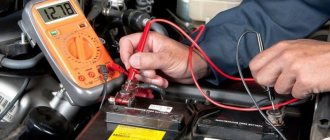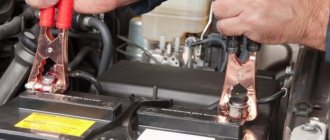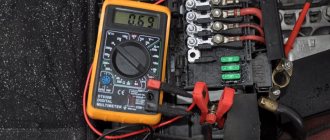A rechargeable battery (abbreviated as AKB) is a device that accumulates and stores energy. When the generator is turned off, it powers the vehicle's electronics and starts the engine. Over time, the battery power becomes depleted. Typically, the battery replenishes its reserve while driving. If you forget to turn off the side lights or do not use the car for a long time, the device will run out of power.
- 5.1 Is it dangerous to charge a car battery in an apartment?
- 6.1 Summer
Preparing to charge
To make the process go smoothly, follow a few simple steps.
- Remove the device from the car;
- Make sure the battery is dead. Check the special indicator. If there is no indicator, use a tester;
- Remove dirt from the body and at the same time inspect it for damage;
- Check the electrolyte level. Normally it covers the plates. If the electrolyte is too low, add distilled water;
- Check the ventilation, unscrew the caps from the cans. In the process, vapors will be formed, which should freely penetrate outside.
Important! If the battery is damaged, do not use it or try to charge it - replace it with a new one.
Battery charging methods
The easiest way to recharge is using modern chargers (chargers) with automatic settings . They relieve the car owner from having to configure settings manually. Simply connect the terminals and plug the device into a power outlet. The process will go automatically.
Other common charging methods include constant voltage method and constant current method..
- With the first method, the voltage remains unchanged (14-16 V), but the current changes and gradually decreases. Keep in mind that the method only provides 80% charging, and the process itself will take about a day. It is undesirable to set high voltage values, otherwise the battery will wear out faster;
- Charging using the direct current method is faster, within 10-12 hours, and also allows you to charge the battery completely to 100%, but requires constant monitoring. Set the current correctly - to a maximum of 10 percent of the device’s capacity. Batteries for passenger cars have a capacity of 55, 60, 65 or 75 Ah (amp-hour, in English Ah), for trucks - from 120 to 190 Ah. So, if you have a battery with a capacity of 60 Ah, set the current to 6 A. When the device is charged to 14 V, reduce the current by half. When the charge level reaches 15 V, reduce the current by half again.
There are also more non-standard methods. Basically, they are designed for those cases when the device is discharged unexpectedly, and you need to quickly resuscitate it.
Charging using a laptop
There’s no charger at hand, no one to light a cigarette, and pushing the car isn’t an option either? A power supply from a laptop or computer and a 21W or 55W light bulb will help out. A light bulb from a headlight or flashlight will do.
Create a simple electrical circuit. Using copper wires, connect the negative pole of the charger to the negative pole of the battery through a light bulb. Connect the positive pole of the charger directly to the “plus”. It is important to maintain polarity. Then plug the charger into the outlet. The light will light up.
In this way, you can revive a dead battery or even fully charge it.
Charging with a screwdriver
The method is similar to the previous one, only instead of a laptop power supply you will need a screwdriver battery . It should also be connected to the battery through a light bulb, which will serve as ballast.
It won’t fully charge the battery, but it will help to “invigorate” it.
Charging using the cigarette lighter
Alternatively, recharging is possible via the cigarette lighter socket . The current and voltage in the cigarette lighter are low, so charging will be gentle. The advantage of this method is that it can be used on the road. You will need to purchase a special charger. There are car-to-car chargers that allow you to charge the battery through the cigarette lighter of a “donor” car. The battery can also be charged by lighting it directly from the battery of another car.
Charging using a welding inverter
If you have a welding machine at hand, you can use it. Please note that the device must have current and voltage adjustments , otherwise the battery may be damaged. One hour is enough for a small recharge.
Charging with a laboratory power supply
The laboratory power supply produces a current of up to 3A, which is quite enough for charging.
You can connect the battery to the power supply using cigarette lighter wires.
Important clarifications and calculations
How long does it take to charge the battery if you want to get a longer service life from it without causing harm? The fact is that any fast charging with high currents can contribute to a decrease in battery capacity , since we are talking about the use of one or another type of charger. It is with them that the confusion occurs. And not only for novice drivers, but also for those who fundamentally do not want to dive into the study of a simple topic related to such concepts as voltage and current.
As you know, there are six “cans” inside the battery. The output voltage of each of them is about 2 V, for a total of 12 V.
However, this indicator is conditional and not entirely accurate:
- the real U of a well-charged battery should be at least 12.6-12.7 V ;
- if it is 12 V or less , the battery is at least 50% discharged;
- if the voltage is 11.6 V or less - a deep discharge, urgent charging is necessary.
Capacity always remains the most important value and depends on how the battery is regularly charged, maintained, and how the battery is operated. The very concept of capacity can be briefly defined as follows: this is the time during which the battery can operate continuously, provided a certain amount of current is supplied.
For example, the most common capacities for car batteries are 55 Ah and 60 Ah. This is followed by batteries with higher ratings of 75 Ah and higher.
The elementary calculations here are as follows (we start from a capacity of 55 Ah, dividing it by the strength of the supplied current):
- When loaded with a current of 55 A, the battery will work for 1 hour;
- when the load is less (for example, 27 A), the battery works longer, 2 hours;
- at a load of 13.75 A, the work will already be 4 hours - and so on.
Of course, a strong current load is not applied to the battery under normal conditions. This is important to know in order to understand the concept of safe current. The safe current figure used when charging the battery should be 10 percent of the battery's rated capacity. Thus, you can calculate the battery charging time in the most basic way.
If calculating percentages is difficult, you can use a calculator:
- for a battery with a capacity of 55 Ah, the percentage of safe current will mean 5.5 A ; Read more about what current to charge the battery →
- how many hours will it take to charge the battery - 55÷5 = 10 hours .
It is very easy to calculate these indicators. They will help you understand that a five-hour express charge for car batteries is clearly not enough. In order for the battery to last longer and not have to be changed frequently, you should understand how to charge the battery in such a way as not to “dead” it ahead of time. It is important not only to achieve a real indicator of a charged battery of 12.6-12.7 V. It is important to ensure that this U lasts as long as possible while maintaining optimal capacity.
Express battery charging using constant voltage method
You should understand why this method is only suitable for emergency situations: abuse of it will shorten the life of the battery. This method is not suitable for devices that have not been working for a long time!
The essence of express charging is to supply increased current for a short time. The current is set to 20-25% of the battery capacity, and charged for a short period of time - one to two hours.
Remember that the express method does not replace full charging . If possible, it is better to use low current for a long time.
Features of charging different types of batteries
There are many types of batteries:
- antimony and low antimony;
- calcium;
- hybrid;
- gel;
- EFB;
- lead-acid, Pb;
- lithium-ion, also known as lithium, Li-ion.
The top quality foreign batteries today include models from such companies as Varta, Mutlu, Bosch. Domestic - AxTex, Akom, Zver, Orion.
Most batteries contain lead plates, but some manufacturers add silver to reduce corrosion. Lines containing silver usually have the word silver in their name.
Rechargeable batteries of different types have different design principles and, as a result, their own characteristics, which can be seen in the table.
| Type | Characteristics | Charging Features |
| Calcium battery | Calcium batteries consume less water than others due to the addition of calcium (Ca) to the plates. They do not tolerate deep discharge well. The battery itself does not need to be serviced frequently, but if it does run low, it will require a complex charging process. | A regular charger in the case of a calcium battery will not give the desired result. To restore the charge, you will need a special device capable of maintaining a voltage of at least 16V. Otherwise, the battery will not be fully charged. Most often, experts recommend the Vympel-55 device. The process is described in detail in the instructions:
The point is that at the last stage the dynamics of charging proceed as if in waves. Voltage and current change. At the upper limit, the values reach 16.1 V and 3 A, respectively, and at the lower limit - 13.1 V and 0 A. The more fully charged the battery, the shorter the charge lasts. When the charge (upper limit of values) lasts several seconds, and the pause (lower limit of values) lasts several minutes, the battery is charged. |
| Hybrid battery | The hybrid combines several technologies: low antimony and calcium. It has two types of plates, and it combines the advantages of both options. On the one hand, the hybrid is less sensitive to deep discharge, and on the other, it has a low consumption of electrolyte and does not discharge much. Hybrids are quite expensive, but are becoming more and more popular. | Charging a hybrid is much easier than a calcium battery; it does not require any special knowledge. The algorithm of actions is the same as for standard charging. If you want to quickly recharge the device, set the current value to 10% of the battery capacity. The method is good for occasional use. You cannot charge the battery at maximum current all the time - it will last less. It is best to set a low current - no more than 2 A, set the voltage to 14.2 V. It will take more time to recharge, but the device will last longer. |
| Gel battery | Gel batteries are the most modern technology. These include AGM and GEL batteries (for example, Varta). The lead plates in them are sealed in a special gel, which prevents the electrolyte from leaking or boiling away. Gel batteries tolerate deep discharge well and are not afraid of cold. They charge quickly, although they also discharge quickly. On the other hand, gel batteries have a high price and are more difficult to charge. | The most important thing when charging such a battery is to set the correct voltage. It should not exceed 14.5-15V. Strong tension will damage the gel and the device will become unusable! Thus, the charger must have the function of adjusting current and voltage. During the charging process, it is important to ensure that the voltage does not exceed the norm, reducing the current if necessary. If the battery is not used for a long time, it is in standby mode, so-called. “stand by use”, and is charged only to maintain it in working condition, then the voltage should be even lower. It is better to look at the instructions for exact data for each model. |
Two types of battery charger
There are two types of chargers:
- Direct current.
- Constant voltage.
Constant voltage memory
The so-called express charging of the battery lasting 5 hours is usually carried out with a popular Chinese charger, which uses the principle of constant voltage (14.4 V). When this device is connected to a battery, it provides more than 10 percent of the current rating: 25-30 A in the first hour of charging. The battery will withstand this current and will charge very quickly, but it will also run out much faster. The current drops in the first 3-4 hours, but the voltage remains constant. In five to six hours the battery will be charged to 90-95 percent.
It is recommended to use such devices only in extreme cases when fast, emergency charging is necessary. However, many car enthusiasts, unfortunately, prefer not to calculate voltage and amperage, but simply buy a Chinese charger that does everything “by itself”. You should not use this method constantly, since in the first hour it gives a very high amperage, which only drops towards the end. If you charge the battery so quickly all the time, it will fail much earlier.
DC memory
In order to properly charge a car battery at home, experienced drivers recommend purchasing a Russian-made DC charger. Both the voltage and amperage on it can be checked very simply - of course, if you know what indicators should be based on. A current of 10% of the nominal capacity of the battery, of course, will not charge the battery in a short time, but will allow it to minimally consume its resources throughout the entire charging process. It is low currents (for example, 5.5 A for a battery with a capacity of 55 Ah) that are optimal and most humane for batteries.
There is various talk among drivers that such precise chargers no longer exist in nature. But in fact, it is quite possible to buy it. Fashionable Chinese “chargers” are certainly more convenient and easier to use. But sometimes it doesn’t hurt to take some actions yourself, even in those conditions when it seems that constant haste is necessary.
Charging the battery at home
To recharge the battery at home you will need a charger. Memory units are divided into:
- chargers operating at low current (ZU-75M);
- pulse starting-chargers with which you can start the engine (Triad, ZPU 135, Orion);
- with manual adjustment (Lavita LA 192309);
- automatic (Kedr-Auto-10);
Instruments for checking voltage will not be superfluous. You will need to remove the battery from the car by disconnecting the terminals with a key.
Is it dangerous to charge a car battery in an apartment?
Follow a few simple rules and everything will be fine.
- Charge the device in a ventilated area with access to fresh air;
- During charging, a dangerous mixture of oxygen and hydrogen is released, which can explode. Keep the device away from flammable objects and open flames. Smoking is prohibited nearby;
- Disconnect electrical cables. Even a spark can lead to dire consequences;
- During charging, harmful fumes are released, so you should protect your hands with gloves, use a mask and goggles.
If the battery is not completely dead yet
How long should a lead-acid battery be charged if, for example, the voltage has not yet dropped to critical levels? It is known that U 12 V means that the battery capacity is already 50 percent or less. But in this case it is not necessary to keep the battery charged for 10-12 hours.
Here are a few more short calculations:
- at a voltage of 12 V, charging time can be reduced to 7 hours, but not less ;
- If U is 11.6 V or less , it is better to charge for 12-15 hours .
During the charging process using a DC device, the voltage changes - up to 13.8-14.4 V. The voltage must be greater than the rated charge of 12 V, otherwise the current from the charger will not flow into the battery. If the battery is completely discharged, in 5-6 hours its charge will be 90-95 percent. In any case, you will have to wait up to 10 hours to reach 100 percent, because the current gradually becomes smaller towards the end of charging.
In conclusion, for novice car enthusiasts, it can also be noted that there is no specific time for charging batteries with different capacities. Everything depends only on the current and voltage indicators, the meaning of which should be understood in order to treat your car’s battery as carefully as possible. With the help of simple calculations and logical conclusions, you can understand that 5-6 hours is not enough time to properly charge the battery. It is better to wait the required amount of time in order to maintain the productive performance of the battery for as long as possible.
How often to charge the battery
Typically, the battery is recharged during travel from the car's generator. But there are times when additional charging is required:
- you drive no more than 10-15 minutes every day. In order for the battery to recharge, you need to travel a certain distance. If you drive little, the battery slowly loses its charge;
- you have not used the car for a long time;
- you have an old battery;
- In winter, the battery was discharged from the cold.
It is best to charge the battery as needed, after first measuring the voltage with a tester.
In summer
Summer is a favorable time for the battery; the battery does not discharge as quickly as in winter, and has time to recharge while driving. But it is still worth monitoring her condition. Most batteries do not tolerate deep discharge, that is, they cannot remain in a discharged state for a long time. If the battery is discharged, it should be fully charged as soon as possible, preferably using the DC method.
in winter
In winter, the car is subject to increased loads. A discharged battery freezes quickly. It is recommended to charge the battery once a month , and also check its overall condition: add distilled water, clean the terminals and ventilation holes. You will have to pay special attention to the condition of the battery if you have an automatic transmission (automatic transmission) and not a diesel engine, because such a car cannot be started from a pusher.
How to check if the battery is charged
There are several ways to find out the charge.
- Check the color indicator. Most often this is a green “eye” in the body. If the indicator is green, the battery is charged, if black, the battery is discharged. The indicator will not show the exact state of charge;
- Measure with a multimeter. The multimeter must be set to measure voltage - voltmeter, set the scale to 20 V and connect the wires to the battery terminals. If the device shows a voltage of 12.7 V, the battery is charged, if the voltage drops to 12.1-12.5 V, it’s time to recharge, and if it drops to 11.7 V and below, it is very discharged;
- Measure with a load fork. The most accurate method, the one used by professionals. The device takes readings under load. Readings of 9.6-10 V are considered normal. If the voltage drops below 9 V, charging is necessary;
- Measure the density of the electrolyte using a hydrometer . The method is only suitable for serviced batteries. Normal density is 1.25 -1.27 g/cm;
- Use a charger with voltage measurement function.
Charging a maintenance free battery
Maintenance-free batteries require minimal effort on the part of the owner. Most companies now produce exactly these: Varta, ACDelco, Bosch. Such batteries are recommended for installation in modern cars, including the popular in Russia models Toyota Kia Rio, Toyota Camry, Toyota Avensis, Volkswagen Tiguan, Volkswagen Polo ).
These batteries are closed type, non-removable, so there are several features when recharging them. You cannot look inside and see what is happening with the electrolyte—whether it has boiled or what its density is. It is recommended to charge them at service stations.
If you need to charge a maintenance-free battery at home, the easiest thing is to use an automatic charger, which itself determines how much current to supply. In the absence of such a memory, you can rely on the indicator in the case. As soon as it turns green, you can stop charging. Or independently calculate the degree of discharge and the required charging time.
Leaving the battery on charge for too long can cause premature wear.
Types of car batteries
Yes, in addition to serviced and maintenance-free, batteries are also divided according to the manufacturing method and the materials used in them to generate voltage:
Lead-acid batteries, the most common today, consist of special lead plates into which distilled water and sulfuric acid are added - this mixture is called an electrolyte. The advantages of such batteries are that they are relatively inexpensive and they do not have the so-called memory effect - when the battery, for example, remembers the charge and cannot be charged beyond that charge without using special shamanic dances near it
Gel batteries - they use a thickened electrolyte to which special silica gel is added, usually these batteries are maintenance-free and provide sufficient current to start the car even when heavily discharged
AMG - AMG battery, similar in design to a lead acid one, but with the difference that the electrolyte is not poured there, but special gaskets that are located between the lead plates are impregnated with it, these acid gaskets simultaneously hold and maintain the integrity of the lead plates, and the acid itself would be inside the gasket and would not leak out. The lead plates for such batteries are made much thinner than for conventional ones, because of this there are more of them and as a result they can create a much higher starting current than conventional acid batteries
Required temperature when charging
The optimal temperature for recharging is from +20°C to +25°C. The permissible temperature ranges from -15°C to +40°C. At extremely low or, conversely, high temperatures, batteries charge less well and run out quickly. It is worth taking into account not only the ambient temperature, but also the battery itself. So, if you bring the battery home from the cold, it will still be cold inside. It is wrong to remove the device from the car every day in winter and bring it home, since the temperature difference through zero harms it.
Charging a new battery
Why charge a new battery? Batteries are charged during production, but during storage they gradually discharge. This is a natural process. Therefore, new batteries need to be recharged before use. The more time passes before purchase, the more the battery will discharge.
Refrain from purchasing batteries that have been in storage for more than six months!
The exception is dry-charged batteries, which are sold without electrolyte. Their shelf life reaches 5 years.
After purchase, evaluate the battery voltage using an indicator, multimeter or load plug and, based on this, recharge or fully charge.
Charging the battery from the laptop power supply
Some car owners, when the battery is slightly discharged, use a regular laptop unit to charge the battery. The main thing is not to confuse the positions of the plus and minus when charging this way, so as not to create a short circuit and burn the laptop charger. Usually, to determine the so-called plus and minus (anode and cathode), a multimeter is used, or on the laptop block itself it is indicated where the plus is inside (in the plug hole) or outside the plug.











